This pretty little female kestrel enjoyed a vole breakfast yesterday morning along the causeway to Antelope Island. I’ll spare you most of the gory details but raptor feeding behavior is one of the many behaviors that I find interesting.
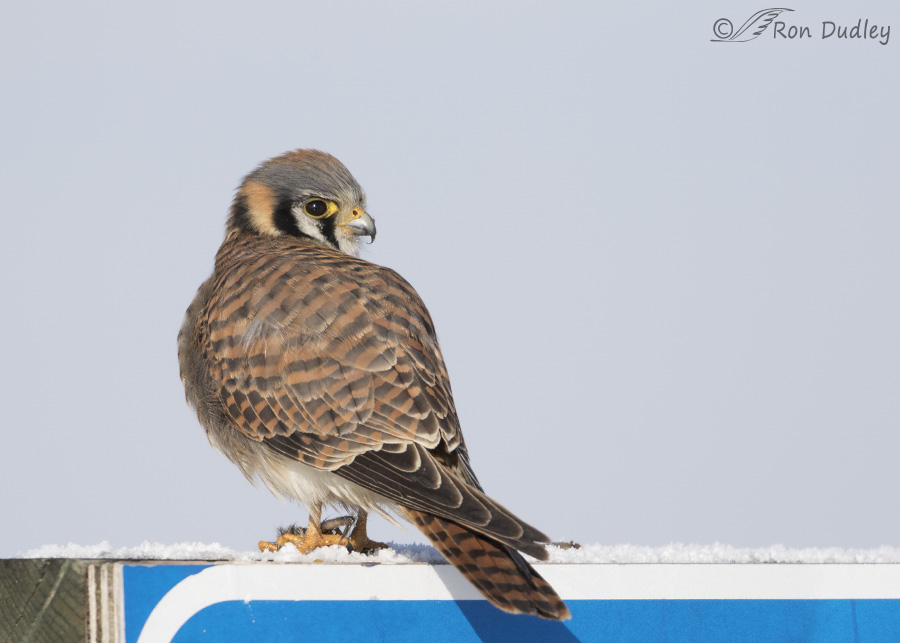
1/3200, f/6.3, ISO 500, Canon 7D Mark II, Canon EF 500mm f/4L IS II USM + 1.4 tc, not baited, set up or called in
She had already consumed some of the vole when I found her on an ugly sign next to the road. She was obviously acclimated to the traffic and paid it and me little attention as she worked on her meal. Regular readers know that I really don’t like perches like this but she obviously has no problem with them so who am I to complain? Besides, behavior is behavior…
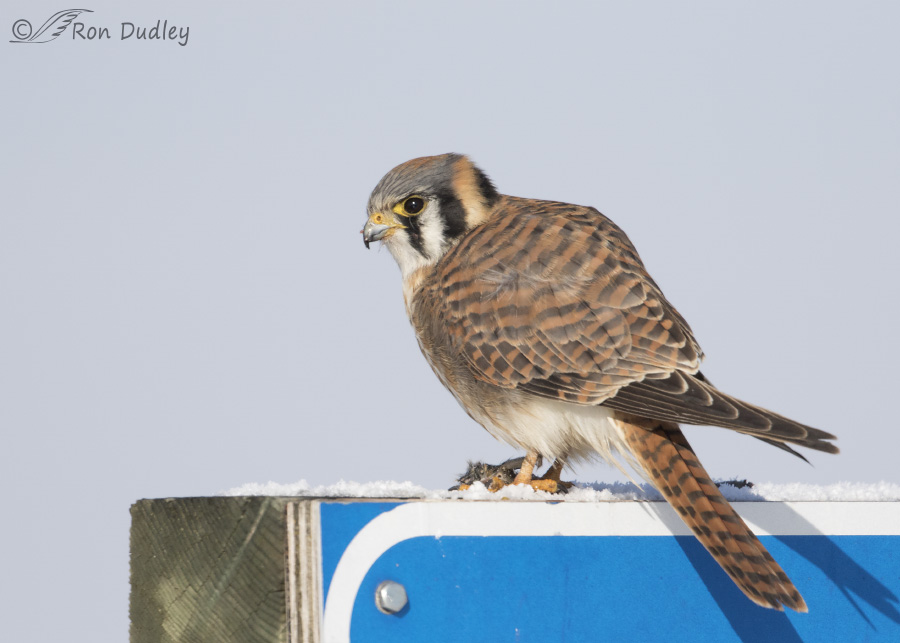
1/3200, f/6.3, ISO 500, Canon 7D Mark II, Canon EF 500mm f/4L IS II USM + 1.4 tc, not baited, set up or called in
By now the anterior portion of the vole had already been consumed – here we see only the tail and the rump.
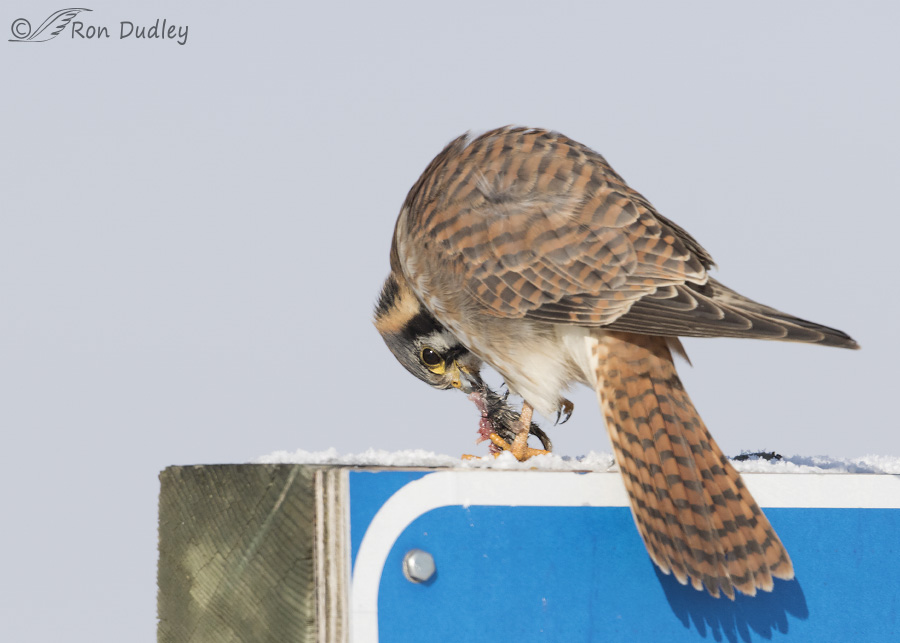
1/2500, f/8, ISO 800, Canon 7D Mark II, Canon EF 500mm f/4L IS II USM + 1.4 tc, not baited, set up or called in
I believe they often choose signs as a feeding perch because compared to a tree branch their width provides a more stable platform. It’s difficult for them to maintain balance when they’re pulling meat off prey and even here she had a hard time keeping her balance so she often had to flare her beautiful tail as a balancing aid.
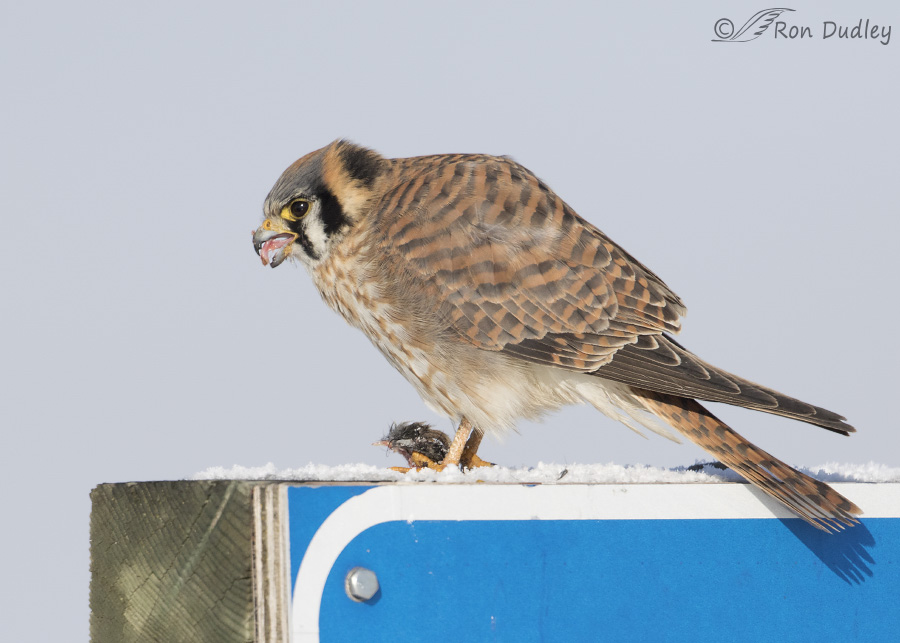
1/4000, f/7.1, ISO 800, Canon 7D Mark II, Canon EF 500mm f/4L IS II USM + 1.4 tc, not baited, set up or called in
I’ve seen kestrels swallow vole pieces as large as what’s left of this rodent in one piece but this dainty little lady preferred smaller bites. She was in no hurry to finish her meal but when another vehicle came by on her side of the road she…
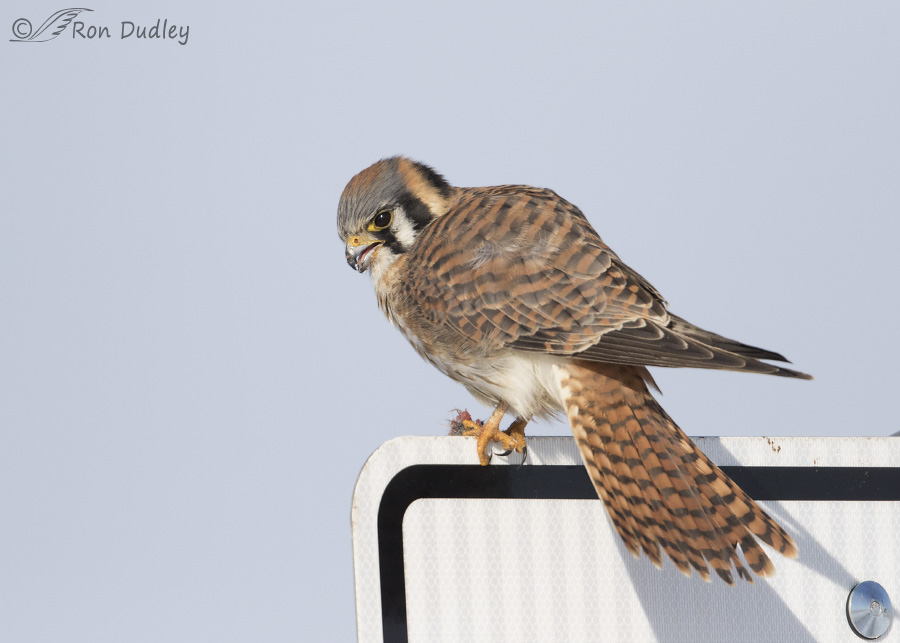
1/6400, f/5.6, ISO 800, Canon 7D Mark II, Canon EF 500mm f/4L IS II USM + 1.4 tc, not baited, set up or called in
moved to another nearby sign but at least this one wasn’t bright blue. I missed the takeoff shots when she lifted off because a phone call came in that I had to take. Terrible timing…
She’s a beautiful little bird but like most falcons she sure could look fierce. As many of my readers can attest, kestrels are the epitome of the phrase “having an attitude”.
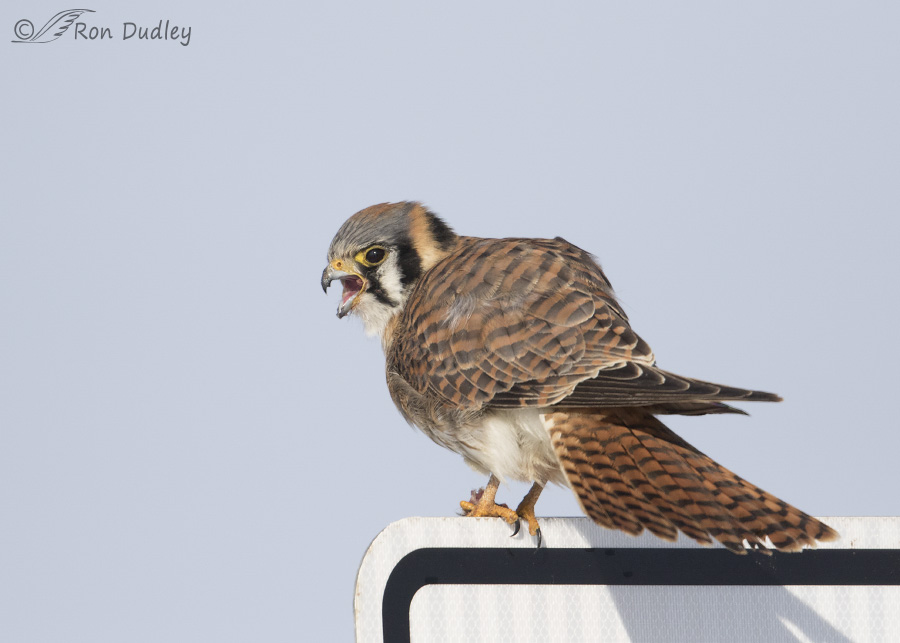
1/6400, f/5.6, ISO 800, Canon 7D Mark II, Canon EF 500mm f/4L IS II USM + 1.4 tc, not baited, set up or called in
This may look like she’s screaming but in reality she’s only swallowing a piece of meat. A tight crop of this image reveals…
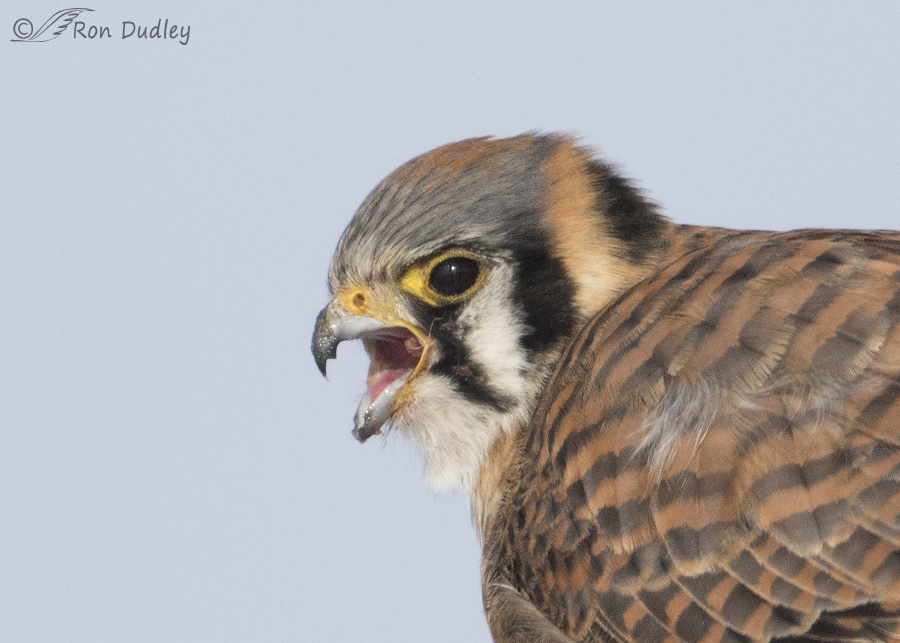
1/3200, f/6.3, ISO 500, Canon 7D Mark II, Canon EF 500mm f/4L IS II USM + 1.4 tc, not baited, set up or called in
a couple of interesting things:
- notice her “falcon tooth” (tomial tooth”), the tooth-like projection on her upper bill. The tomial tooth of falcons is used to dispatch their prey, often by severing the spinal cord.
- to my untrained eye it looks like her lower bill may have a slight anomaly – it appears shorter than it should be and almost looks like the end of it has been sheered off or worn away. I remember the tip of the lower bill to be more cup-shaped but I could be wrong. Any feedback on this from knowledgable readers, either way, would be appreciated.
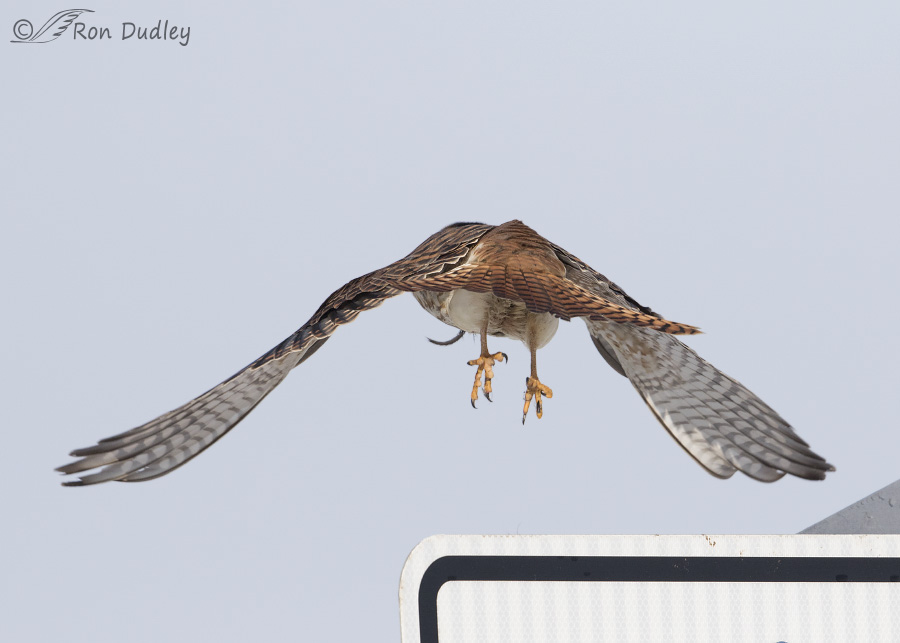
1/6400, f/5.6, ISO 800, Canon 7D Mark II, Canon EF 500mm f/4L IS II USM + 1.4 tc, not baited, set up or called in
She added to my growing collection of butt shots when she lifted off with what was left of the vole. I was under the impression that she had eaten her fill but was reluctant to abandon the leftovers.
Perhaps she cached them – a common kestrel behavior, especially in winter.
Ron


You should be glad Ron you din’t catch a little “attitude” from her departure! lol Laura – I loved your story of Syke!
I had attitude from the get-go, Nancy. I didn’t need to catch it from her!
An interesting series and interesting comments….I’m always glad to see a kestrel doing anything…just seeing one is reassuring….like the butt shot as I get to count the feathers in the tail and check outb rear view details. They sure do have some attitude ( what’s with these little guys…little dogs, little birds (like hummers, chickadees, wrens), ponies,little men and lkestrels???). I’ve never been afraid of a big dog or horse, it’s the little ones that scare me….
I’m not sure, but I think this bird may either be wearing a toupe or doing a trumpian comb-over…..
If so I hope it’s the former, Patty. I don’t want anything “trumpian” in any of my photos…
Bottom beak looks normal to me. Great shots.
It looks like the consensus among those in the know is that the beak has no anomaly. Thanks for that feedback, Louise.
And once again, WOW!
Yeah, attitude with Kestrels is amazing. To illustrate, let me share yesterday’s hunt. The female Kestrel I’m flying now, Skye, has attitude on steroids! Yesterday, she flew really well, staying in the tree tops, however, my objective was that she catch a vole, which required a lower altitude attack mode. She chased two, but of course, they’d skedaddled to shelter (invisibility) by the time she arrived at where they were when she took flight. After a while, I called her to the lure, and after two nice, long passes, she landed on the ground about 10 feet from me, giving me the stink eye in the spirit of I want what I want when I want it, and that’s immediately if not sooner–then added several expletives, disrespecting my lineage all the way back to cave times!
I didn’t want to reward THAT behavior, so I hid the lure from her behind my back as soon as she landed. When I failed to produce her lure, which is a small bird-shaped leather affair covered with a starling skin, she lowered her shoulders and marched, literally marched, toward me (and you know how silly raptors look when they walk/march). She reached the end of her march at my hawking boots, reached out and footed my boot then bit it with attitude and looked up at me with a mega stink eye. I was laughing so hard (in my head, of course) that it almost leaked out! When that strategy didn’t work, she flew up to my shoulder and kakked in my ear, using all sorts of expletives and curses, turning the air blue. I offered her the fist (without a tidbit), but since that was totally unacceptable and I was utterly non-compliant, she flew to a tree for a quick pout. I walked away and when she followed, I called her to the fist with her meal, the top half of a mouse with all the goodies (heart, lungs, liver, and of course, brains and eyes).
The picture in MY mind is of Giant Tweety from cartoons of old. I can’t help it. She’s so much bigger than she looks.
As for the beak, it looks perfect to me. In fact, I’m going to save a couple of these photos for a guide for when she needs to have her beak coped. Thank you!
I was hoping you’d chime in on this beak thing, Laura – if anyone would know it would be you. Thanks!
Loved your Skye story. She seems like a little devil and I love that in a kestrel. It just fits…
Thanks Ron…this one is a spitfire and I’m pretty sure that attitude thing is a hallmark of being a Kestrel. I don’t think I’ll ever forget the mind image of her marching up to me and footing/biting my boot! Of course, while I had the camera in my pouch, I was totally out of hands–two are just insufficient–and I was too busy watching her behavior and developing my response.
Wonderful shots Ron!
Charlotte
Thank you, Charlotte.
Beautiful bird and shots of her, Ron. No idea on the lower beak, but everything seems to fit together there. Love the more subtle coloring of her compared to the males.
I like those more subtle colors too, Judy.
Fascinating series. Love starting my day here.
And I love having you here, Arwen.
i can’t look at a female Kestrel without bringing back memories of the female I had long ago and use to fly. Wonderful memories!
Excellent set Ron, thanks for sharing.
Thank you, Dick. I envy your time spent with a kestrel, long ago or not…
love the tomial tooth shot for you can also see the notch on lower beak where tooth fits. no clue about the shape of lower beak…. she seems to be surviving…
Carroll, Yes, if there is anything unusual about her beak it doesn’t seem to affect her much if at all.
A fine looking little falcon and possibly a juvenile, though it’s not easy to tell the age of a late season female kestrel.
Her beak looks fine to me. The end of the lower beak in healthy falcons is in constant contact with the inside of the upper beak and the resulting wear helps keeps it the proper length.
Thanks for the feedback on the beak, Mark!
I love studying photos of birds in flight, especially falcons. It’s interesting that when she takes flight in the last photo, her right right wing is rotated so much that mostly the underside is in view. Pretty cool photo!
Interesting observation, Mark.
Would her dainty eating habits and tail fanning for balance on a wide perch also indicate a first year bird?
I don’t know for sure, Pam, but I doubt it. I’ve seen the same from quite a few other kestrels in situations like this.
No, that’s normal behavior when they’re eating on a thin surface. It takes a lot of effort for them to pull a mouse/vole apart. Some of the pieces don’t come apart easily–and by that, I mean long strings of skin/fur, especially along the critter’s side that don’t break apart. I’m not explaining this well. Would that I had an illustrative photo, but don’t be holding your breath on that one–that’s Ron’s department!
Beautiful full sized pics of a very little bird…nicely done.
Thank you, Zaphir. Yes, kestrels are quite small and often difficult to approach.